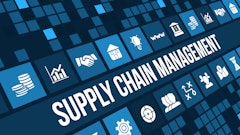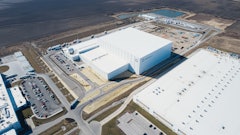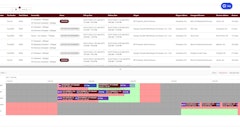
Over the years, executing a risk mitigation plan has transformed from something that’s nice to have to something that every company must have, at all times, in all facets of the organization.
From the influx of cargo theft, cybersecurity threats, food safety and driver shortage to geopolitical tensions, strikes from rail/dock workers, natural disasters and more, even the smallest gap can pose serious threat to people, product and plant.
Liken it to the blind leading the blind, getting lost in a maze or driving while blindfolded.
Not being able to see ahead and predict and plan accordingly is what sometimes plagues many of today’s supply chain companies.
That’s why mitigating supply chain threats is of utmost importance heading into 2024.
Marina Mayer, editor-in-chief of Food Logistics and Supply & Demand Chain Executive, talks exclusively with Amy Childress, VP of monitoring, cargo for Copeland, about the reason behind cargo theft’s unprecedented increase and more.
CLICK HERE to read the article in full.
Food Logistics: What are some of the cold food chains biggest threats to date? And why?
Amy Childress: Due to persistent supply chain instability, a lack of visibility to perishable goods moving through the cold chain is arguably the biggest threat. Having tools that can monitor, track and record cargo conditions — such as temperatures and locations — historically and in real time gives businesses and stakeholders the information they need to take corrective actions. Proper temperature management, which is an ever-present concern, is even more critical for protecting food quality and safety in the face of potential supply chain disruptions.
Businesses need to work closely with their producers, carriers and cold storage/distribution facilities to implement a monitoring infrastructure that can help to eliminate blind spots in their discrete cold chain networks. Copeland’s GO real-time 4G/5G tracking devices and cloud-based Oversight software are designed to provide that end-to-end visibility.
Driver shortages and economic conditions impacting the over-the-road trucking industry are only exacerbating challenges. Inflation is raising the costs of new tractor trailers and driving down prices within the used truck market, removing barriers to entry for many independent drivers. Unfortunately, older trucks lose approximately 5% of their insulative capabilities (i.e., R-value) every year, making them more prone to temperature management issues. Rising fuel prices also make drivers more likely to take steps to save fuel, such as not using a continuous refrigeration mode during transport. These factors put perishable food quality and safety at risk while highlighting the need for a robust temperature monitoring infrastructure.
Food Logistics: 2023 saw a lot of instability within the supply chain, such as geopolitical sanctions, natural disasters, inflation, etc. From your vantage point, how do these factors impact/influence the way companies can mitigate supply chain threats?
Childress: Collectively, these factors contribute to a complex set of cold chain challenges. With so many dynamic variables seemingly out of their control, companies need the tools to help them simplify cargo management and strengthen the performance of their supply chains. This starts by ensuring that every link in their perishable cold chain is equipped with a proper monitoring toolset and adhering to their quality assurance (QA) best practices.
It’s also essential for companies to utilize robust monitoring tools to uncover negative trends in their carrier networks — which are often not readily apparent. For example, Copeland’s Oversight software and cold chain experts leverage advanced data analytics to create comparative performance scorecards of carriers, track historic and/or seasonal patterns, and identify stress points. Companies can use these insights to make informed decisions, alleviate problem areas, and improve overall supply chain network resiliency.
Food Logistics: According to multiple sources, the average value of cargo stolen during reported events in 2023 was $214,104, equivalent to an estimated $223 million in cargo across 1,778 reported theft incidents. What can be accredited to the rise in cargo theft?
Childress: There’s no question that cargo theft is on the rise. According to a recent report from CargoNet, the second quarter of 2023 saw a 57% increase in cargo theft compared to the second quarter of 2022. Thieves are focusing on high-value shipments, with the average shipment valued at $260,703, of which food/beverage is the top target, followed by electronics.
This unprecedented increase largely can be attributed to shipment misdirection attacks, a strategic form of cargo theft in which thieves and criminal networks steal the identities of motor carriers and logistics brokers. After assuming their victims’ identities, thieves can then obtain their freight, misdirect it from the intended receiver, and steal the cargo.
This emerging scheme makes cargo tracking a mandatory element in companies’ security strategies. A real-time tracking and monitoring infrastructure can alert stakeholders when cargo is diverted outside of planned routes or makes unplanned stops to change hands. In addition, built-in light sensors — such as those on Copeland GO real-time trackers — alert stakeholders when a cargo door has been opened unexpectedly.
Food Logistics: Labor disruptions are also substantially higher this year, up 136%, according to Resilinc data. This includes company and site-level strikes, national strikes, layoffs and labor protests, among others. What does this mean for the future of cold food supply chains?
Childress: Labor has been a persistent challenge for stakeholders throughout the food cold chain for several years, with no signs of letting up. Looking forward, companies need tools to automate manual labor-intensive tasks and free up valuable staff members to focus on high-priority, customer-facing responsibilities. They also need advanced software and data analytics tools to simplify cold chain management and aggregate multiple datasets into a centralized, cloud-based repository. Copeland’s Oversight software and cold chain experts are dedicated to helping stakeholders identify weaknesses in their supply chains, inform decision-making, and provide the insights to guide the most effective use of resources.
Food Logistics: What are some things not addressed above that may be pertinent to our readers?
Childress: Sustainability is at the core of what we do at Copeland. The industries we serve provide a significant opportunity to capture long-term growth and create additional value for our customers, while making a significant impact on the planet.
It’s estimated that 40% of all food produced globally is wasted, which represents roughly 10% of GHG emissions worldwide. Reducing that waste by just 5% can prevent 50MMT of CO2 – that’s the equivalent to removing 10 million cars from the road each year. But with the world’s population expected to hit 9.7 billion by 2050, the demand for fresh food growing by 60% in the same time period, and increasingly complex global supply chains coupled with rising food costs, the challenges of producing and transporting food effectively and efficiently are growing.
Keeping perishables at their ideal holding temperatures during transport helps reduce spoiling, extend shelf lives, and minimize food waste. In our cargo business, our tracking and monitoring solutions are designed to inform growers and retailers if their perishable products are outside safe temperature ranges and when they are at optimal freshness, helping customers to predict, prevent and resolve problems as they occur.
Copeland solutions are in use at critical points across the food value chain – from the transportation of food over the road or ocean, and the storage of food at stops along the chain, and at point-of-sale in supermarkets and restaurants. And we are positioned to take advantage of new opportunities related to the digitization of the supply chain and real-time tracking.
CLICK HERE to read the article in full.



























